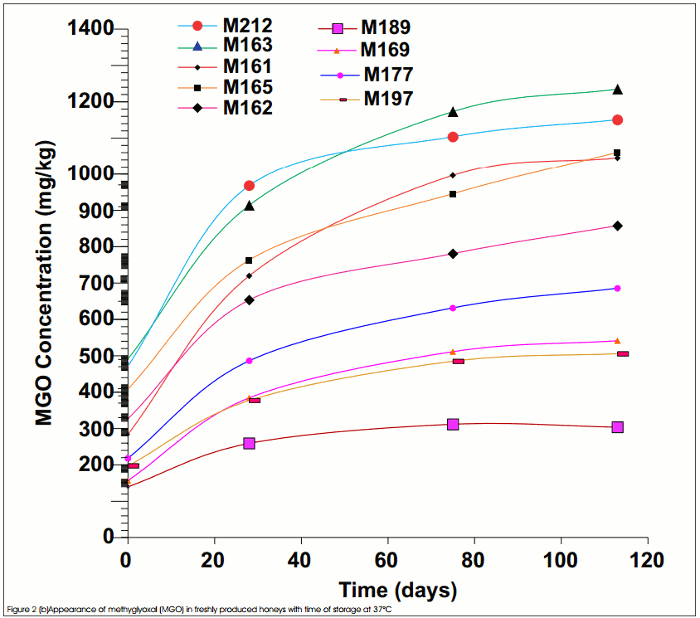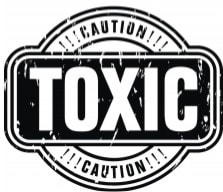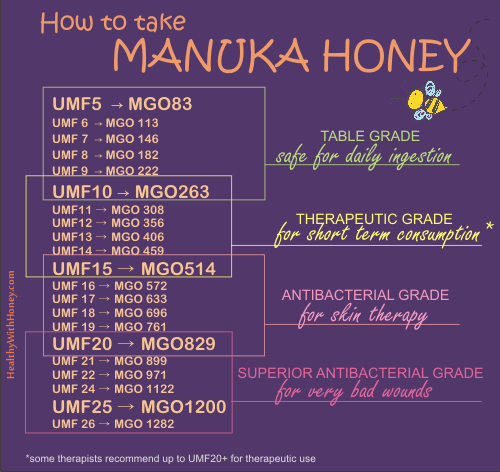We ask this question because manuka honey contains MGO. So, is manuka honey safe? What is MGO anyway?
MGO comes from Methylglyoxal and is a substance belonging to dicarbonyl group (a group of toxic substances). Manuka honey contains very high levels of this substance (over 1,000 ppm), hence the concern regarding its safety.
How toxic is MGO?
MGO is the main precursor to Advanced Glycation End products (AGEs)(wikipedia link). These are harmful compounds that can affect nearly every type of cell and molecule in the body and are thought to be one factor in aging and in some age-related chronic diseases. These substances can lead to the development or worsening of many degenerative diseases, including Alzheimer’s disease, cardiovascular disease, stroke, eye cataracts, cancer and diabetes. They are also believed to play a causative role in the blood-vessel complications of diabetes mellitus. AGEs speed up oxidative damage to cells and alters their normal behavior.
It is also true, that our body can detoxify this compound with the glyoxalase system. This enzyme system exits in any living creature, from the simplest life forms to mammals. Which should again, makes us realize the importance of detoxification of MGO.
Normally our body can detoxify these compounds, when they are found in some limited quantities. But our today lifestyle is working against our health, and we need to detoxify more and more MGO. Among others. Can we afford to add some other huge quantities of MGO from manuka honey? We need to consider the possible good effects as well as the negative ones very well.
If you want to buy manuka honey but don’t understand the grades, please read this article first:
Deciphering manuka honey: UMF15+, MGO400, 24+ Bio Active, KFactor16, TA. And LOTS OF FRAUDS.
What contains MGO?
• Methylglyoxal is present in many foods and drinks, including coffee, and is produced during glycolysis and sugar fermentation. There is more MGO especially in roasted instant coffees, decofeinized or brewed coffee and soya sauce. Many other foods also contain MGO, (but less than 10 ppm, even in bread at 0.5 ppm or beer at 0.03 – 1 1 ppm), but that is a much smaller percent. Some manuka honeys have over 1000 ppm, and this increases in time (as shown below). So there cannot actually be a comparison.
• It is produced by many strains of bacteria present in the intestinal tract.
• It is also present in tobacco smoke.
Some dietary glycation compounds in foods may pose a health risk. Others, such as the so-called melanoidins in coffee, may also exert beneficial effects by inhibition of tumour-related enzymes. (according to professor Henle)
What do the studies say about MGO alone?
The Interantional Agency for Reasearch on Cancer, in its monographs on the evaluation of carcinogenic risks to humans, published in Volume 51, METHYLGLYOXAL, the laboratory tests done in order to decipher MGO’s effect.
 The results said the following:
The results said the following:
Methylglyoxal induced sister chromatid exchange, chromosomal aberrations and micronuclei in cultured human cells. It induced sister chromatid exchange and gene mutations in cultured mammalian cells. ln yeast, it increased the frequencies of reverse mutations and of mitotIc gene conversion. ln prokaryotes, methylglyoxal was mutagenic in the absence of an exogenous metabolic system. Methylglyoxal forms adducts with guanine bases and nucleic acids. (brrr…)
There are no data on the carcinogenicity in humans of methylglyoxal (MGO). There is inadequate evidence in experimental animals for the carcinogenicity of methylglyoxal.
Yet, these studies are done on MGO alone, and not in a honey combination. Honey is not only methylglyoxal, but a lot of other factors, and some of them still need to be identified and understood.
MGO is bad for people with irritable bowel syndrome.
The study from 2014 Methylglyoxal Induces Systemic Symptoms of Irritable Bowel Syndrome, by Shuang Zhang et al. from China, nalyzed the effect on MGO on rats. The results showed that MGO induced all symptoms associated with Irritable Bowel Syndrome, especially the form associated with diarrhea.
So, besides having a higher fructose content – which in IBS patients will ferment and lead to worse symptoms, manuka honey also contains a high amount of MGO which alone produces IBS. The best advice would be not to take it.
further reading: Can I have honey in IBS?
MGO is bad for people with diabetes.
High MGO levels are already found in diabetic patients, and are thought to be due to excess blood sugar.
In the medical world methylglyoxal and AGEs are called dicarbonyl stressors and considered pathogenesis factors in diabetes, responsible for many other complications. Diabetics even take a drug meant to lower the levels of MGO; supplementation with this substance from manuka honey would be detrimental.
Yet, application of manuka honey on diabetic foot ulcers is safe and very effective.
To see the whole process and what recent studies have discovered, please read Can diabetics eat MANUKA HONEY?
According to latest research, besides diabetes there are other conditions that would impose a restriction from eating manuka honey: renal failure, hypertension and sepsis.
What do the lab studies say about MGO in Manuka Honey?
 Professor Dee Carter says that MGO binds to protein and DNA, and is very toxic to human cells when it’s not contained in honey. When it is contained in honey it will not damage human cells, but still kill bacterial cells. And that is still a mystery scientists have to elucidate. She says “methylglyoxal on its own is toxic, but when it combines with what are, as yet, unknown compounds, it causes “multi-system failure” in bacteria.”
Professor Dee Carter says that MGO binds to protein and DNA, and is very toxic to human cells when it’s not contained in honey. When it is contained in honey it will not damage human cells, but still kill bacterial cells. And that is still a mystery scientists have to elucidate. She says “methylglyoxal on its own is toxic, but when it combines with what are, as yet, unknown compounds, it causes “multi-system failure” in bacteria.”
Here is a short list of some of the bacteria and viruses that Methylglyoxal has been shown to kill when tested in a lab environment:
Helicobacter pylori – the bacterium known to cause many stomach ulcers and duodenal ulcers
Staphylococcus aureus or MRSA – also known as the super-bug for its high level of resistance to most available antibiotics
Escherichia coli (E. Coli) – known to cause serious food poisoning
Streptococcus pyogenes – a virus that causes sore throats
Helicobacter pylori is a bacterium found in the stomach, which may affect up to half the world’s population.
While it is frequently without symptoms, under certain conditions causes chronic gastritis and gastric ulcers. It is also linked to development of duodenal ulcers and stomach cancer.
And because the antibiotics have often failed in killing the bacteria, manuka honey has been tested. Professor Henle’s studies has showed that manuka honey with high levels of methylglyoxal is stable in the stomach and, therefore, may offer a promising cure and improved gastrointestinal health. YET,
Clinical trials say somethig else:
“Twelve non-diabetic patients with positive CLO tests but normal gastroscopies were studied. Active H. pylori infection was confirmed with 14C urea breath tests. Six patients were treated with a tablespoon of manuka honey 4 times a day for 2 weeks and 6 were treated with honey and omeprazole 20 mg twice a day for the same period. The batch of manuka honey used possessed non-peroxide antibacterial activity equivalent to 11.7% phenol. All 12 patients remained positive for 14C urea breath tests. It is concluded that manuka honey is ineffective at eradicating H. pylori.” (source: http://www.airborne.co.nz/manukaantibacterial.shtml#Pylori2)
So,
While its efficiency was very well proven IN VITRO, the clinical trials in New Zealand, and subsequently in UK, showed that manuka honey failed to be effective against Helicobacter pylori in the stomach.
Further research is needed, with different dosage rates, before any claims of curing stomach ulcers can be made.
Other research, as the one described here: How to kill antibiotic resistant demonstrate that according to other lab studies, manuka honey was able to 100% eradicate bacteria when in a single form, but the percent was of only 62% in eradicating MRSA biofilm forms.
• A study that says manuka honey UMF20+ is safe if a healthy person ingests 20 g/day for 4 weeks in a row
In 2009, The British Journal of Nutrition was publishing a clinical trial made in New Zealand, demonstrating the safety of manuka honey UMF 20+ on healthy individuals. They use Manuka honey UMF 20+ and multifloral honey (for comparison), both from Comvita.
Neither of them changed the levels of IgE or CML, or altered the microflora of the gut. It was thus confirmed that manuka honey UMF 20+ is safe for ingestion, but it also showed no beneficial effects on lower gut bacterial levels. (!!!)
It is important to add that the patients were given only 20 g (1Tablespoon) of manuka honey per day, taken half in the morning and half in the evening, and that the trial lasted for 12 weeks like this:
2 weeks a diet completely without any type of honey
4 weeks of manuka honey (20g/day)
2 weeks washout (no honey)
4 weeks of manuka honey (20g/day).
The persons in the trial were all healthy. This is important to know, because someone with an unbalanced state of health or under specific medication can react differently. When a body is already healthy, honey does not modify anything. Why break the balance?
Anyway, more clinical trials, are to be done, with different manukas and different other honeys.
MGO quantities in manuka honey increase over time! OMG!
A different research, published in 2009, made at Waikato University in New Zealand, has shown that MGO in manuka honey is derived from dihydroxyacetone (DHA). A substance that can be found in different quantities in the flowers of some L. scoparium sub species.
To quote from the research: “All the manuka nectars contained dihydroxyacetone (DHA) but in varying amounts” and “…. there is variation in the amount of dihydroxyacetone in the nectar and that certain manuka trees have the potential to produce honeys with high nonperoxide antibacterial activity, whereas others do not.” 
Ii was also showed that MGO increases over time, as DHA decays into MGO as we can see from the graphic presented here (and the picture). MGO doubled in concentration in the first month of storage and many tripled in under 4 months of storage.
(at these large quantities, will the yet-unknown compounds of honey be able to combine with MGO and keep it from intoxicating us?)
In 2011 a research made in Australia (home of the manuka bushes) found DHA/MGO in honey, from 4 manuka species and it seems that many others of the over 80 species of manukas will contain DHA/MGO. How can we know of what sub-species of manuka our jar of honey is made of? (according to airborne.co.nz)
Some researchers say that when found in manuka honey MGO is safe.

On February 2012, Professor Henle from the Institute of Food Chemisty, Technical University of Dresden, said that dietary methylglyoxal in manuka honey is stable under the conditions of the mouth, throat and stomach, where it can kill bugs that cause infection. When MGO reaches the small and large intestine, it is rapidly degraded into lactic acid.
We know it does that, because our defense system has its counterattack enzymes, but the question is, can they neutralize such a massive quantity of MGO?
Professor Henle says: “The findings show unambiguously that methylglyoxal in manuka honey is not absorbed into the body and does not pose a dietary risk for consumers. Manuka honey is safe to eat – people can eat as much as they like, whenever they like.” (yet, the quantity of MGO is not mentioned. And this toxic component can range in manuka honey from zero to over 1200, even 1750 mg/kg in berringa honey.).
When is manuka honey safe for sure?

When it is used externally. On any type of skin damage, even on complexion (diluted in special masks). Or, as gargling solution, or nasal sprays to combat the golden staph.
Amazon offers such a nasal spray which was proved to be safe on mucosa (in the picture). Please read Can manuka honey treat sinus infection? Are there some other natural alternatives?
Manuka honey with UMF5+ up to 10+ is safe for daily ingestion, alone or with your meals. Yet, do not exceed the recommended dose for any honey, of 1g/kg bw/day.
Conclusion?
We discussed here the safety of eating this type of honey, and not about using it externally.
Manuka honey, with a high content of MGO, was proved to be effective in killing potential bacteria associated with mouth, neck and stomach, in all studies made IN VITRO. Yet, there are some clinical trials that failed. More research is needed to clear if and how this honey should be taken, and what are the potential negative effects.
Manuka honey with a high content on MGO is a powerful stuff. It is safe for topical use, but when taken internally it should be taken like antibiotics. If you need to take manuka honey with higher UMF, take 1 tablespoon per day for 4 weeks and then keep 2 weeks without it (this is a low dose, but is the dose verified in a trial). Do some tests and take some more if still need it. (half the dose for children). Or take a higher dose but for a shorted period of time.
If you have an acute problem, you can take more at your choice, but know that the clinical trial was done only for the above specified dose.
Manuka honey with UMF5+ up to 10+ can be taken daily, alone or with your meals. Here is clear picture you should save somewhere for easy reach:
So, because it is a research in course, you must know that you proceed at your own risk. Don’t believe everything you read. Search for more info, sooner or later, there will be more clinical trials and more results. Or simply follow your instinct and that little voice you hear when your body is telling you what it needs.
(I promise I will stay updated and if you receive my newsletter, you will find out the latest news on this topic.)
What is your experience with manuka honey?
Do you want to be informed about the latest research regarding honey? Subscribe to newsletter, because we are dedicated to finding all about honey!
Related posts:
Deciphering manuka honey: UMF15+, MGO400, 24+ Bio Active, KFactor16, TA. And LOTS OF FRAUDS.
I want to buy manuka honey. What is UMF 16+, MGO 400+, Active?
*****************
***************
References:
The Interantional Agency for Reasearch on Cancer;
http://www.manukahealth.co.nz/news.cfm?article_id=155;
http://www.airborne.co.nz/manuka.shtml;
http://www.airborne.co.nz/manukaantibacterial.shtml#Pylori2;
http://umf.org.nz/research-pdfs
Manuka honey against Helicobacter pylori. McGovern-DPB; Abbas-SZ; Vivian-G; Dalton-HR, Journal-of-the-Royal-Society-of-Medicine. 1999, 92: 8, 439; 1 ref.
“toxic sign” picture courtesy Vlado, via Free Digital Photos





